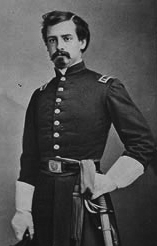Henry B. Hidden facts for kids
Quick facts for kids
Henry B. Hidden
|
|
|---|---|
 |
|
| Born | 1839 New York City |
| Died | March 9, 1862 (aged 22–23) Sangster's Station, Virginia |
| Buried | |
| Allegiance | United States of America Union |
| Service/ |
Union Army |
| Years of service | 1861 – 1862 |
| Rank | First Lieutenant |
| Unit | 1st Regiment New York Volunteer Cavalry |
| Battles/wars | Sangster's Station † |
| Relations | William Henry Webb |
Henry B. Hidden was a brave soldier during the American Civil War. He was born around 1839 in New York City. He died on March 9, 1862, at Sangster's Station, Virginia. Hidden was a First Lieutenant in the Union Army. Many believe he was the first cavalry officer from the Army of the Potomac to die in battle. He was also likely the first officer from a Union volunteer cavalry unit to be killed in the Civil War.
Henry B. Hidden's Life Story
Henry B. Hidden was born in New York City to a wealthy family. His family was related to William Henry Webb, a famous ship builder.
He joined the Union Army on August 5, 1861. He became a First Lieutenant in Company H. This company was part of the 1st Regiment New York Volunteer Cavalry. This group was also called the "Lincoln Cavalry."
On March 9, 1862, Lieutenant Hidden received an important order. He was to take a small group of soldiers to investigate enemy activity. They were near a bridge that Union soldiers were building. This bridge was at Sangster's Station in Virginia. Sangster's Station was a railroad stop southwest of Fairfax Station.
Hidden and his 14 dragoons (cavalry soldiers) found many Confederate soldiers. There were about 150 Confederate soldiers. Even though Hidden's group was much smaller, he ordered a charge. A charge is when soldiers rush forward to attack the enemy.
During the fight, Lieutenant Hidden was shot in the neck. He died soon after. The rest of his scouting party was either hurt or captured.
Hidden was buried in Green-Wood Cemetery in Brooklyn, New York.
Artists Remember Hidden's Charge
Lieutenant Hidden's brave charge inspired many artists. They wanted to show his courage in their work.
Victor Nehlig painted a picture in 1875. It was called An Episode of the War — The Cavalry Charge of Lt. Henry B. Hidden. This painting is now at the New-York Historical Society.
Frank Leslie also drew the Sangster's Station fight. His drawing was in a book called The Soldier of Our Civil War (1893).
A poem was also written about his charge. It was printed in the New York Evening Post newspaper.
Images for kids



